The Ultimate Guide to Competitor Analysis
Lisa-Marie Cabrelli
You don’t know how it happened.
All of a sudden, you noticed a dramatic drop in your revenue, your traffic, your conversions.
You turn around, and there he is. Rearing his giant ugly head, baring his sharp teeth dripping with saliva… a competitor.
You turn to your left and in the near distance you see another, headed quickly towards you. You turn to your right, another. You look ahead, another.
You are surrounded.
Now you have a problem. Now you are on the defense.
Time is running out as you struggle to identify the reasons your competitors have caught up with you. You start to drop balls and make mistakes as you focus your attention outward. Your business starts to suffer from neglect as, all the while, the monsters are stealing big bites with their sharp teeth.
Had you been on the offense you would have been prepared. Had you known exactly what each of these monsters looked like, had you catalogued their strengths and identified their weaknesses, you would have been more than prepared for battle. You would have seen them coming from a mile away.
You should have completed a thorough and detailed analysis of your competitors.
Getting distracted from your business by competitors is a mistake. When you sweat and cry over their successes and go all green-eyed with constant comparisons, you are shifting valuable focus away from the work that needs to be done within your own business. If you have completed a thorough and detailed competitive analysis you can create a focused plan to address your competitor’s strengths and capitalize on their weaknesses. You don’t have to waste precious time and energy worrying about competitors because you know that you have it all under control. Once the initial in-depth analysis is complete, a monthly review for updates and new entries in to the market will suffice.
If you have never completed a full competitive analysis before I would set aside an entire day for un-interrupted focus. In order to illustrate that this method works no matter what type of business you are in, we are going to switch up examples throughout the article.
Let’s get started.
Step 1: Identify Your Competitors.
We will evaluate each competitor individually but first you need to understand the scope of competition in your market by making a list of everyone out there. Remember a tiny competitor today could become that saliva dripping monster tomorrow if you don’t pay attention. Here are some methods for discovering the monsters in your market.
Google Search
Use your main industry keywords and scroll through the first 5 pages of Google. You should be aware of every competitor you discover here. These are the main players. Another strategy is to use the long tail marketing keywords for your best-selling products. The results from this search may turn up some surprises. These competitors are usually the ones creeping up on you under the radar.
For example, assuming I have a cufflinks store, “cufflinks shaped like dollar bills” turned up a result in the #2 position that didn’t appear at all in the first 5 pages of a search for “cufflinks”.

Google Alerts
Create Google Alerts for every keyword related to your industry and product set and have a comprehensive report delivered to your inbox. You might catch a competitor before they even start.
SpyFu
Continuing on the cufflinks example I am going to head on over to SpyFu and hunt down some more competitors. I can plug in a url for a competitor I have found so far (I will use the cuff art example) and spyfu will give me lots of yummy information (most we will be coming back to later) including my top competitors using paid ads and the top organic competitors.
Use the Facebook search box to find the business pages of your competitors (I entered the keyword “Coach” in the example below)
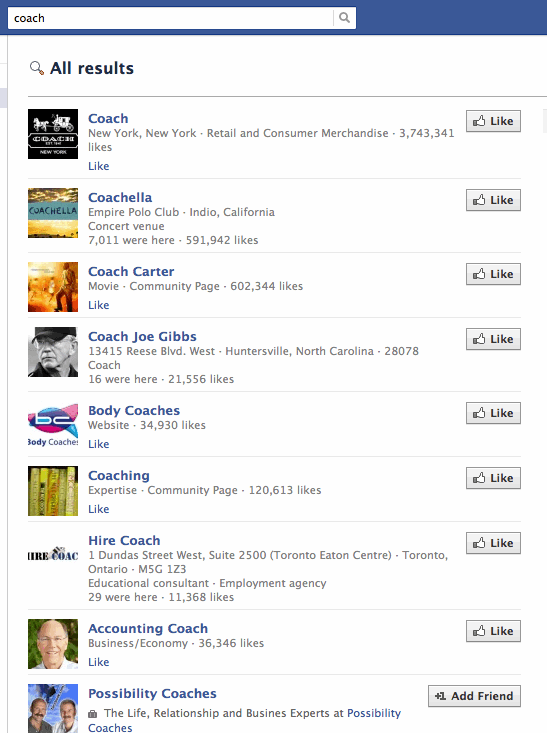
You can set up searches for your main and long-tail keywords in Twitter and add them to a permanent list with a tool like Hootsuite. This method is great, not only for identifying existing competitors, but also for early spotting of new competitors coming in to your market. In the example below, I assumed that you were a company offering SEO services and did a quick search for “SEO”. I got a competitor as the top result.
LinkedIn Groups and LinkedIn Answers are both great resources for identifying competitors. If you were a Dog Trainer you could easily identify competitors by joining the myriad of groups available on LinkedIn for Dog Training (who knew?).
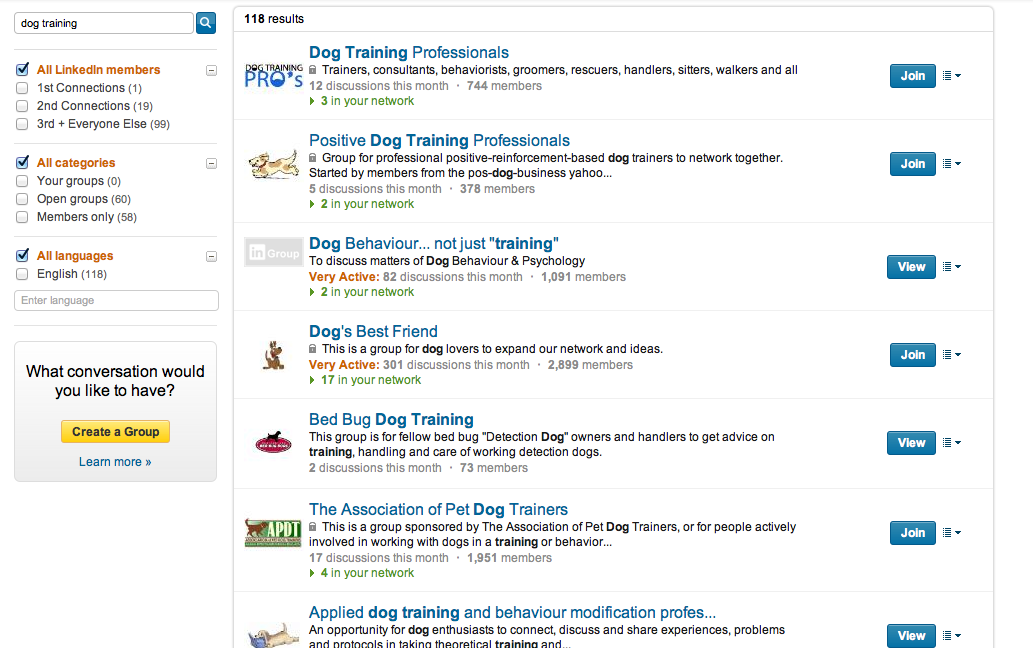
You can also head on over to LinkedIn Answers and identify competitors by evaluating who is answering dog training questions (again… who knew?)
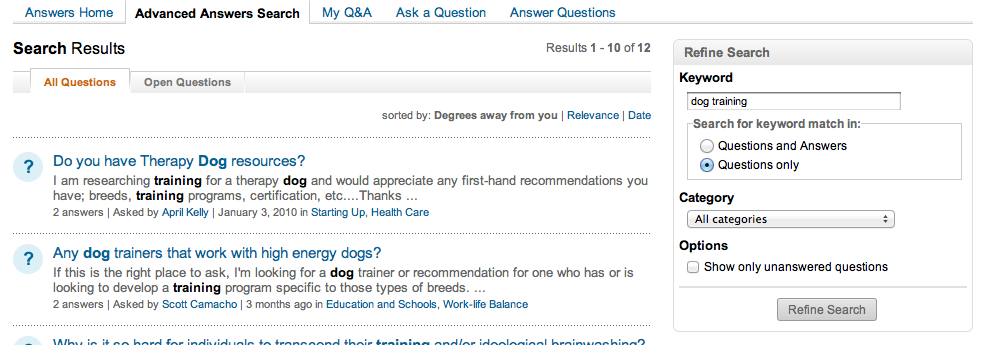
Now that you have your list of competitors it is time to get down to business. It’s not possible to complete this in-depth review for every competitor on your list in a single day, so start with the top 5-10. You should have a pretty strong anecdotal idea who the biggest threats are in you industry. Start with the top and then schedule a weekly competitive review time so that you can work your way through the rest of your list. Remember, a small competitor today may not be a small competitor tomorrow. By using this method you will be able to quickly identify competitors primed for a meteoric rise.
I have attached a PDF worksheet that will guide you, step by step, through the collection of this data. My recommendation is to create an individual manila folder for each competitor and slip the attached worksheet and all supporting documents inside – you will be thankful for the easy reference when you need to address a competitive situation.
Click here to download the PDF worksheets
Remember with are looking for competitor strengths that we need to guard against and competitor weaknesses that we can exploit.
Step 2: Branding Review
A strong brand identity can give you a distinct competitive advantage. Essentially a strong brand tells a customer, immediately, without question, what they can expect from your company. A competitor with a stronger brand than yours is dangerous.
Overall Design
Without thinking too much about it write down your initial impressions of the overall design. This is the same impression a customer will get when landing on this page. Is the design so bad that the company looks amateurish? Do they have a logo? Is it appealing and easily recognizable? Is the color scheme consistent?
What are their strengths? How can you learn from them? Do they use a strong design element such as rotating images? Do they have an unforgettable slogan?
What are their weaknesses? How can you target them? If the majority of your competitors don’t even have a logo (which is more common than you’d expect) throw your logo on everything. Make your logo synonymous with your products and offerings. If their home page is a hectic, jarring mess, make your home page easy on the eyes with calming colors and lots of white space. A competitive review is also useful for recognizing your own weaknesses as they are reflected back to you. Do you have any negative reactions to a design element that you also have in your branding?
Story (About Page)
Branding is about story. If your competitor can draw your customer in to a good story, and make them want to hear the end of that story… they’ve won. Check your competitors for a story. Even the most basic of products and services can have a story. Here’s an illustration using a most basic products… diaper bags.
Let’s say you are in the process of designing and launching a new diaper bag, or, you have decided that there is no diaper bag store online that has the ultimate selection so you are going to create a store (I would strongly advise anyone against creating a niche product store without manufacturing but that’s another story). you are in the middle of your competitive review and have found two websites that are similar to yours in design and branding – they are both ranked similarly and it is obvious at first glance that they are targeting the same customer base as you are.
Let’s take a look first at La Dolce Diaper Bags. This one is an easy one. No story. It’s a pretty website and has nice bags but you don’t know (and can’t find out) anything about the company or the people who run it.
What are their strengths? How can you learn from them? Because we are exclusively looking at story in this section of the branding review you would probably conclude they have none.
What are their weaknesses? How can you target them? They have no story. You can create a story and include that story throughout your brand. Sure others will still shop with La Dolce for style or price but it is much easier to engage with a brand, trust a brand, and buy from a brand again and again if they have a good story.
So let’s look at another example Ju Ju Be.

What are their strengths? How can you learn from them? They have a nice story. One owner talks about her obsession with organization and makes little self-disparaging jokes. The other owner talk about his family and reveals his wife’s nickname “muffin-frog”. You find out that the company is named after one of their daughters. They have great family photos on the page – they look like nice people, you feel like you know them.
What are their weaknesses? How can you target them? Although you can imagine them meeting and starting this business together you would like to know the story behind it. How did they find each other? How did they decide to go in to diaper bags? Maybe they have a fun story about a diaper bag disaster with one of their kids that made them realize they needed to create their own? They mention social media but you would like to know more about what they talk about on their social media platforms – you want to know why you should keep following their story. Why should you root for them and their company?
Message
What is the overarching brand message that this competitor is projecting? Do they have a message at all? A strong branding message let’s the customer know immediately that they have landed in the right place. A strong competitor sends a very specific message that narrowly targets his ideal customer base. As Seth says, “If you are telling a story for everybody, you are telling a story for nobody” If your competitor is strong in other areas AND has a very strong brand message you would be wise not to try and compete with a similar message. Be sure to tweak your messaging until it is truly unique. I have had competitors copy my e-commerce store messaging word for word on to their own stores, but it did nothing to make them a stronger competitor. It wasn’t their message. Using your competitor’s strengths to inform your strategy works, copying your competitor’s strategy doesn’t. After all, there can be many women’s networking groups, but there can only be one Secret Society For Kick-Ass Women.
Step 3: Web Presence Review
A long time ago when I was starting out in eCommerce I sat down at my computer with a long list of product ideas based on keyword research. The next step was to find out how strong the potential competition was in each of the niche product markets so that I could evaluate the ease of entry. Each potential competitor received a score based on the following elements and the market with the most lowest scores won. This method can also be used to evaluate and strategize around your existing competitive market. I have continued to use this method to stay ahead of the competition.
Email Marketing (Reciprocity)
A strong competitor practices reciprocity, one of the 6 pillars of Influence from Dr. Robert Cialdini. They give a lot before they expect to get. The first thing I always check for is a mailing list sign-up, after all. If they have a list sign-up right away. There is a lot to learn from your competitor’s email marketing.
What are their strengths? How can you learn from them? Is there something about their sign-up box that immediately caught your eye? I love Danielle LaPorte’s sign-up box. It’s easy to find, tells me what I am going to get and lets me choose the frequency of my mailings – it makes me trust her more. Where is the sign-up box locate on their page? Do they have a fabulous offer that made you itch to enter your email? This gentleman tells me I can have an entire hour of his time for free – pretty compelling. When you get their emails do you open them? If so take some time to think about why… do they have compelling headlines? Is there content stellar? Are they good at telling stories? Use what you learn and apply it to your own list-building and emailing marketing.
What are their weaknesses? How can you target them? Was there something about their sign-up box that turned you off? Did you get sent to a gimmicky up-sell landing page? Did you NOT get a double opt-in? How about their email marketing? Are their emails badly formatted? Do they have boring re-hashed content? Find their weaknesses and focus on making your company the obvious choice by comparison.
Mafia Offers
Make sure that all of your offers are Mafia Offers – An offer that your customers can’t refuse and your competitors can not duplicate. Obviously all of your offers should be Mafia Offers, but you should be on the look out for Mafia Offers on your competitor’s website. If they are creating Mafia Offers they are dangerous. You should use this observation to focus intently on other areas of weakness for this particular competitor – put him on the top of your list.
Call To Action
When you land on your competitor’s website do you know what to do next? Is there a strong call to action? Do you find yourself moving deeper and deeper in to their website because every time you get to a page the next step is clear? Analyze why and use that information to bolster your own call to action.
Testimonials
Another of Robert Cialdini’s Pillars of Influence… social proof. People will do things that they see other people are doing. This is especially important in industries with jaded and skeptical prospects – why is why you see so many photos and praises on “Internet Marketing Scheme” landing pages. Does your competitor have testimonials? Where are they located – one page or sprinkled throughout the site? Do they include photos, videos, big names?
Social Media
You must evaluate four things when analyzing your competitors social media presence. Audience, Social Proof, Community and Authority.
Audience – where is your competitor finding his audience? Is Twitter an appropriate social media channel or is Facebook stronger? Does everyone in your industry have a LinkedIn company page? Does your competitor have a blog? Chances are that your competitors have already tested and settled on the main social media channels that work for your market so take in to account which channels seem the most prevalent. But – don’t overlook an opportunity. Is no one in your industry using Twitter because they don’t understand it? Maybe you can fill a void? Test it and see what happens but don’t neglect the established channels for your market or you may find yourself behind the 8 ball.
Social Proof – Again, people will do things that they see other people are doing. So social proof is all about numbers. When a prospect finds your Facebook page they will immediately look at the number of fans to make sure that you are worthy of other customers. How many fans does your competitor have, how many Twitter followers, etc… Of course, it is very simple to game the system (you can buy Facebook and Twitter fans on Fiverr for a fiver) so you might want to have a quick check with a service like Fake Followers to get the true measure of your competitor’s social media influence. This doesn’t help you much in the numbers game as most of your prospects won’t know about fake followers, but it does give you an advantage when you build your social media strategy as you will know where to put your focus.
Community – Read all of the comments in every one of your competitor’s social media channels. How strong is the loyalty of their customers? What are they saying about the brand? What are they praising… this tells you their areas of strength that you can learn from. What are they complaining about… this tells you their areas of weakness that you can exploit. Are the prospects/customers commenting, sharing the content, interacting with each other? Dig down to try and uncover the essential elements that are the building blocks of your competitor’s community and apply these learnings to your strategy.
Authority – Is your competitor considered an authority on your subject? Does she have a blog? Does she have a fabulous press page like Pamela Slim? Has she authored best-sellers like Gary Vaynerchuck. Establishing expert status authority is a great way to gain a competitive advantage. Of course, if you are just starting out this will take some time – but understanding the strengths and weaknesses of your competitors can help you focus your authority strategy.
Neighborhoods (Target Customer)
Head back to Google to do some neighborhood research. We want to know where your competitor is hanging out and who they are hanging with. Search on the name of the company, the url and the names of any of the individuals involved with the company. We will use this strategy later on in Part 4 to give us some insight in to the competitors SEO savvy (back linking strategy) but at this point we are just trying to understand the message your competitors are sending through the company they keep, get as much information as possible about their online activity and niche marketing strategy as well as identify possible forums, organizations, groups where your company should have a presence. Are they dropping comments on specific forums? I bet there are customers there. Have they guest posted articles on certain websites? Customer are there too. Do they belong to specific organizations? Are they listed in certain directories. You need to be everywhere your competitors are and then be somewhere else – and, for good measure, a few more places
Part 4: Traffic Review
If your business relay on web traffic one of the most important steps of the competitive analysis is the traffic review. It is imperative that you know how much traffic your competitor is receiving in comparison to you, where they are receiving their traffic from and what you can do, once again, to learn from their strengths and exploit their weaknesses. I would like to qualify the above statement by reminding you that traffic isn’t everything… but conversions are. Don’t get hung up on traffic numbers exclusively. It may be true that your competitor is kicking your butt in traffic by wasting advertising dollars. You won’t know that unless you have completed a full traffic review.
Please remember that there is an entire, very complicated industry based around SEO and traffic. This is not, by any means, intended to be a tutorial or comprehensive review on SEO – but a quick set of basic tools that you can use for the purposes of a competitive review.
Targeted Keywords
You should already have a nice solid set of keywords representing the search and social media traffic that you would like to capture for your business. If not you can find some good keyword training here. It’s free. For the purposes of competitive research we want to find out what keywords your competitors are targeting here’s how.
The quick and dirty source code check. You can see very clearly clearly what keywords your competitors are targeting by webpage by simply visiting a web page and clicking “view source”. For this example we are going to assume you have a local New York wedding planning business. Do this…

and you get this….

The best part about this is the level of detail. Not only is your competitor telling you exactly which keywords they are targeting, but they are also illustrating exactly how they are organizing their website and content to best target those keywords.
Revisit SpyFu to find some more of your competitor’s targeted keywords. Enter the url of your competitor and you will get results for both paid and organic keywords that the company is targeting as well as their current Google rank for that phrase. Here’s our wedding planner’s results:
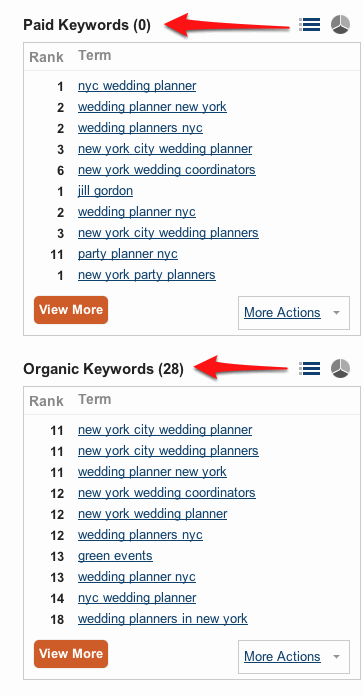
You can also visit Domain Tools and find another list of targeted keywords for our wedding planner:
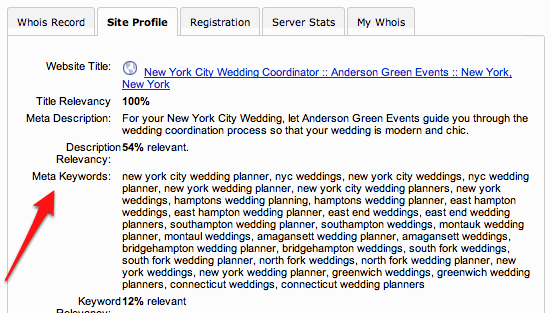
SEO Savvy
Again, it is important to note that their is a LOT of steps, tools and knowledge required to do a thorough, detailed SEO focused competitive analysis. These tips are intended only to give you a sense of your competitor’s SEO savvy. In other words, how hard they are to beat. If you get good results out of this quick review then you definitely want to dig deeper in to SEO and take advantage of the opportunity.
Out of the myriad of markers we can use to judge a competitor’s SEO savvy we are going to use only a few as a high-level check: Page Titles, Page Rank & Google Backlinks. To complete this part of the worksheet you will need to install the SEO Quake Toolbar – we will only be scraping the services of this toolbar’s capabilities.
For this example we are going to assume that you are planning on opening a dog-walking business in Miami. You have decided that your major keyword phrase that represents your business is “Miami Dog Walkers”. You go to Google and plug in the phrase.
Page Titles: Does the page title (also the blue underlined link in the Google results) contain keywords? I would say that #1 isn’t necessarily that SEO savvy as they have included a phone number in their page title, a waste of title keyword space. Dig in to their website a little and see if their inner page titles (the words that show up at the top of your browser window) are keyword savvy.
Page Rank: The small box on the left hand-side of the listing indicates page rank. There is a lot of discussion about the lessening importance of page-rank in SEO, but what it does tell you pretty reliably is how hard a company has been working on their organic rankings. At a page ranking of “1” for all of these results, I think we can assume they haven’t been working that hard on it at all – which shows a competitive opportunity.
Google Backlinks: All indications so far show that it should be pretty easy to assume the #1 position on Google for the keyword phrase “Miami Dog Walkers” simply by putting some effort in to building some back links. To get a ballpark idea of the number of back links you would need to beat the competition you can do a back link search in Google. To do this you enter the word links in the search bar followed by a colon, a space and then the url in questions placed within quotes. The results for our top 2 listings are below. Again, back links aren’t the main driver of Google rankings by any means so don’t assume this is the case. What this does tell you is that you probably have a little more work than you expected to reach the #1 position but #2 should be relatively easy. Don’t forget we are only checking the main keyword phrase for your business. There may be extensive and unexplored competitive opportunities for your long-tail keywords. I would also check phrases such as “doberman walkers in Miami” or “dog walkers in (insert zip-code)”, etc…
Paid Traffic
There is a chance of course that your main competitors are paying for all of their traffic. If this turns out to be the case then it is up to you to figure out whether they are super smart at paid advertising (and paid advertising is a must for your industry), just loaded, or perhaps just stupid (and of course we all hope it is the latter.) To find out how much they are spending on PPC you can go back to trusty SpyFu. This time (yes, this competitive analysis does apply to all industries) we are going to look at the traffic for a wooden toy maker.
In this example Spyfu gives us a ton of information. Including: the amount spent daily on ppc advertising, the ranking for that website for both ppc and organic, the value of organic traffic, the percentage of paid vs. organic traffic, the keywords that this competitor is spending money on and even the actual copy they are using in their best performing ads.
If you spend the time to complete the attached worksheets and complete a thorough and detailed competitive analysis you will be rich with valuable information that you can use to seriously kick your competitor’s butts. You need to understand exactly who your competitors are, evaluate their branding, monitor and understand the strengths and weaknesses of their web presence and, if you are a traffic reliant company, complete a thorough traffic review. Unfortunately, once you start applying the strategies you discover in your analysis and racing past your competitors, they will be sure to notice you. It is vital that you make a regular appointment with yourself to review your data, strategy, positioning any changes in the competitive environment.
How are you doing against your competitors? Did you learn something that surprised you?
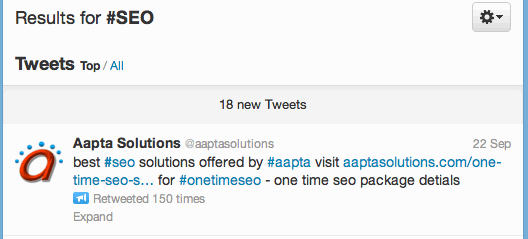
bharathi.b
thanks for your valuable posting it was very informative. i am working inBest Crm Software Chennai
Michael Atlas
Nice article,
This list sure is comprehensive, no denying that. I like the steps that have been outlined here. They’re all certainly useful, particularly the one about Social Media marketing and SEOs.
One thing I’d like to add though is that maybe for some companies this can get overwhelming and perhaps an alternative can be to let an outsider conduct a competitor analysis for them. I remember my friend having worked for a company which did just this from an outside firm called SQM (http://goo.gl/A4pecZ). The results were satisfying and since the company didn’t have the time to conduct it itself, I guess it was a good decision after all.
Might be something to consider. In any case, thanks for sharing this.
Steve Baines
Wow – the headline wasn’t kidding this is the “ultimate guide”!
Nice Work
I love the “Mafia Offers” – I talk about that all the time but love the title, I will for sure be using that title now 🙂
LaptopLifeLisa
Thanks Steve! It’s the “competitor’s can’t replicate” that makes it truly mafia right? After all there is only one Don Corleone.
jared
wow, epic post on competitive analysis. As a Search Analyst myself for a digital marketing agency… this is good stuff. Thanks for sharing!
LaptopLifeLisa
Thanks Jared! Digging in to your happiness stuff. Love it!
Mike Kawula
Huge rich content filled post, thanks! Love your slogan “Grab your Laptop, Get a Life” , thats awesome. Been a very big project recently is this will defiantly help. Hard competing against Amazon who tends to take a lot above the fold……long project! Thanks Again, this was awesome!
LaptopLifeLisa
Thanks Mike! It is very difficult to compete against Amazon with a community-based niche product, impossible with a commodity product. If you manufacture any of your cleaning products yourself though it can be a goldmine. Let me know if you do and you decide to list… I know a few secrets 😉
Mike Kawula
Thanks for the feedback. No manufacturing. 200,000 items all dropship from 5 partner locations.
LaptopLifeLisa
Thanks for reading Olga! I’d love to hear about your results.
Olga Astakhova
Great article, Lisa, thanks a lot!
I’m also a huge fan of SEO and happy to see every new tip and tool for it. Now, with your comprehensive instruction and PDF, I will be able to master all other aspects of competitor analysis and apply it in practice.
hyderali
Fantastic post lisa!
Truly, all the points you’ve listed are essential to analyse your competitor.
But I must diagree when you say “paid advertising is a must for your industry” when you are doing thorough research on your competitor for ranking above him in SERPs then I don’t think you must also see whether he is doing ppc or not. Infact, if you know you can do all the stuff what your competitor is doing (with improvement) then you can definitely go above his ranking.
If you are doing this analysis for paid then you should not do any analysis but just keep increasing your bid & you’ll be automatically on top of your competitors.
I always go with this sentence “SEO takes time but once you achieve the ranking it’s worth”.
Thanks for the post.
LaptopLifeLisa
Thanks for the comment hyderali. I am a huge fan of SEO and built my eCommerce business on it (I don’t spend a dime on PPC :-)). The article actually says that the competitor analysis can be used to figure out whether “paid advertising is a must for your company”. I do believe that there are some industries where you will not be able to break in without paid – even if you just use ppc while you build your organic rankings. As you know (and point out) strong organic rankings take time and not everyone has time to wait for the revenue to come in. I don’t believe that paid advertising is a must for every company, but I do believe it can be the right strategy in many circumstances.
Christopher Hufnagel
Great post! This has been a strategy I have used in the past, love your outlook on it.
Laptop Life Lisa
Great tool for the SEO part of the analysis Christopher. Thanks for adding to the competitive analysis arsenal!
Jimmy Haddad
Hey Danny, thank you for the awesome post.
However, I couldn’t manage to find the mentioned “attached PDF worksheet”.
I must have missed the link. Any help?
Thank you!
Danny
Oops, sorry Jimmy, we forgot the links.
I’ve added them into the post, and you can download the worksheets here:
http://www.firepolemarketing.com/wp-content/uploads/2012/10/CompetitorReview.pdf
Jimmy Haddad
Thank you!